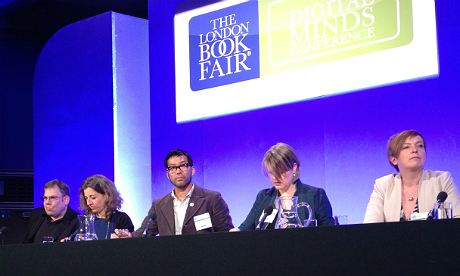
For much of the book publishing world, the move to digital is all about e-books. That brings big challenges (and regulatory scrutiny) around distribution deals and pricing, but less around the actual content and design.
For children's books, it's a different story. The text-centric e-books market has seen children's publishers turning their picture-books into apps.
A session at the London Book Fair's Digital Minds conference explored the implications with panelists from publishers Macmillan, Penguin and Nosy Crow, and transmedia production firm Starlight Runner Entertainment.
The key theme: making great book-apps for children is very different from making books: it's a collaborative process requiring animators, coders, musicians and above all storytellers with a feel for interactive narrative.
"It's a much more collaborative process," said Kate Wilson, managing director of Nosy Crow, which has made critically acclaimed apps based on Cinderella and The Three Little Pigs, as well as its own Bizzy Bear books.
"It's hard to look at any of our apps and say 'this person made that'… It has, so far, to make a rich experience required more input from many many different disciplines."
Eric Huang, publishing director at Penguin's media and entertainment division, said his company is signing up developers and animators to create picture-books, and launching them as apps before physical editions. "The new breed of authors isn't necessarily coming from a literary background," he said. "They're still storytellers."
Starlight Runner president and chief executive Jeff Gomez, who has worked on franchises including Pirates of the Caribbean, Tron, Halo, Transformers and Hot Wheels, predicted the rise of "the new children's book rock stars" – writers who understand the fundamentals of interactive design.
However, he warned that this is about much more than "the equivalent of Choose Your Own Adventure… thinking interactivity means choosing through some kind of branching format".
Instead, it's more about "involving the reader as a participant in some form or another in the narrative, so that the decisions that the participant makes and the activity that the participant does have an impact – subtle or overt – on the narrative".
The panel agreed that the emergence of tablets and smartphones has been the main reason children's book publishers are excited about digital storytelling, while Huang noted that seeing other children's entertainment companies like Nickelodeon, Disney and Moshi Monsters in the apps space has been an additional spur.
One question is what parents' expectations are of storytelling apps for their children. Gomez praised tablets for "removing the last frontier of friction" for children, who don't need to physically turn pages or learn to use a mouse.
"There is a direct relationship between the child and the app or the digital book, and it is manipulateable with tremendous ease," he said. Wilson, meanwhile, pointed out that the ability to offer voice narration means children aren't reliant on their parents to read to them.
Is cutting parents out of the storytelling loop an entirely good thing? Belinda Rasmussen, publisher at Macmillan Children's Books, warned "it would be a shame if that came at the expense of the emotional value of the book: of the parent sitting…"
Wilson added that parents are actively involved in the apps that their children use, and pointed out that book publishers may benefit from this: reading experiences may be seen as the "least worst" option on a tablet, which they feel "more positive about than Angry Birds, perhaps".
The panel highlighted two big challenges for children's book publishers, though. The first comes down to money.
"Children's books make money: a good amount of money. And the expectation on the part of publishers is that they won't make that much money on the digital format," said Gomez. "That's a big stepping on the brakes for a lot of publishers."
He had a solution: pay more attention to intellectual property rights, and think from the start how a particular story might extend across other platforms and devices, whether that's comics, animation or games.
The second challenge for book publishers is how to stay relevant in a world where teenagers and even younger children's expectations of storytelling are influenced by nonlinear content, particularly games.
Wilson defended the idea of linear narrative – "stories with a beginning, a middle and an end are very satisfying for children… The reason that J.K. Rowling worked is that it's a better story than any of my children could tell themselves!"
However, Gomez said it's more about bringing these linear narratives into bigger, nonlinear worlds: "A living, breathing world where as you're moving through the linear story, there may be other things happening elsewhere in the story world that are unfolding on different platforms".
He also warned book publishers that they must learn and find new partnerships quickly, with the risk if they don't being that the business of children's storytelling will be driven by other kinds of companies.
"If you don't do something about this, that's exactly what's going to happen," he said.

